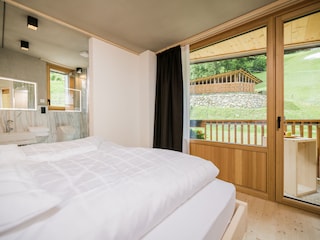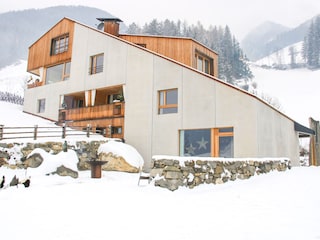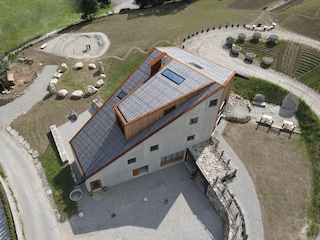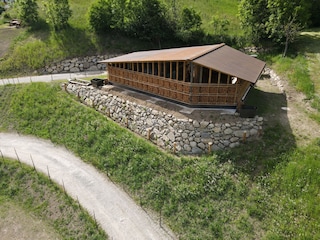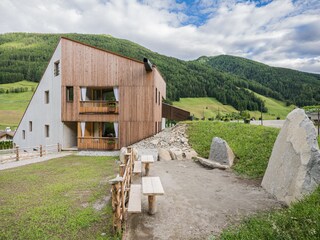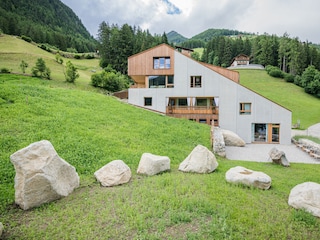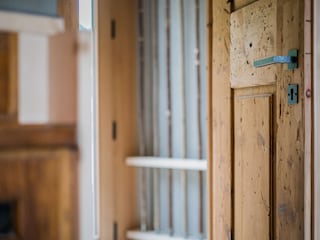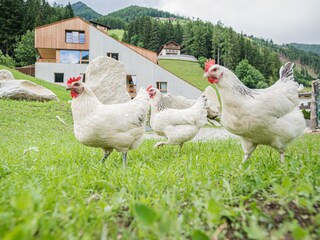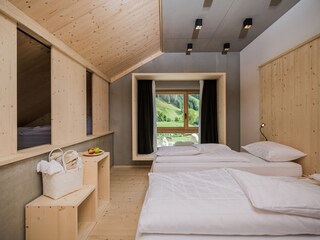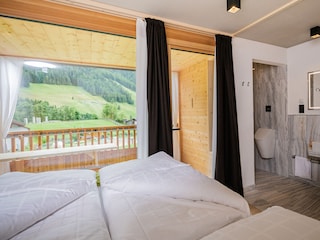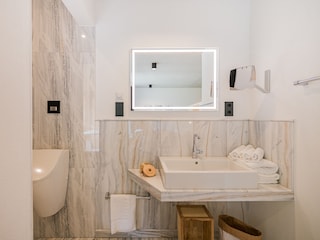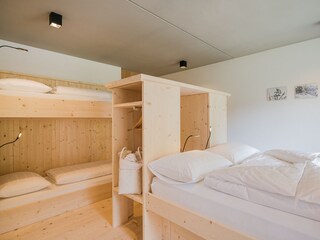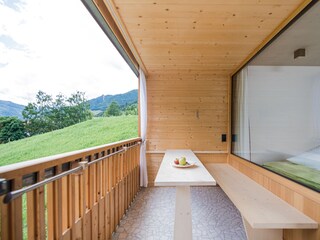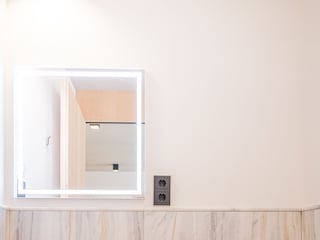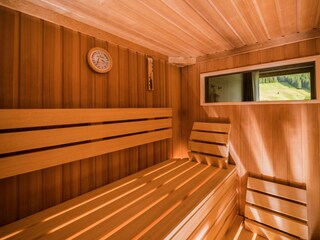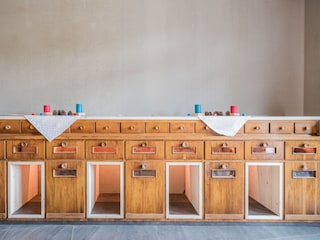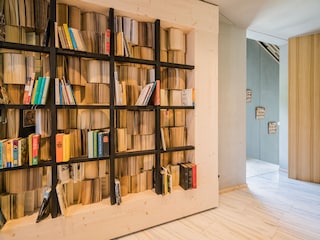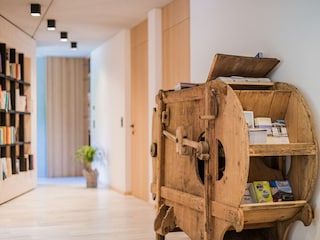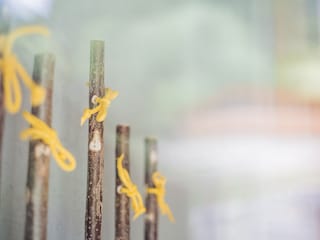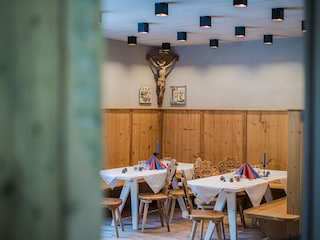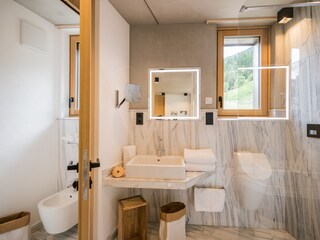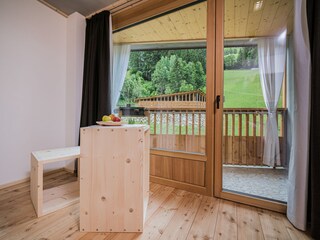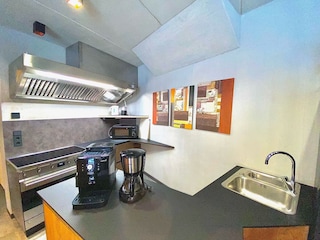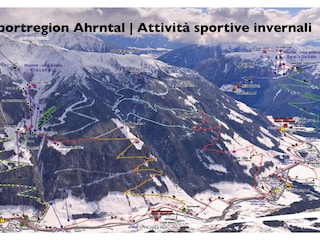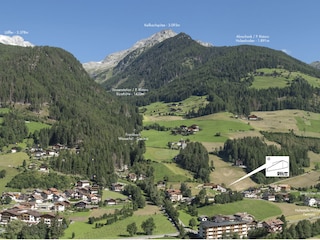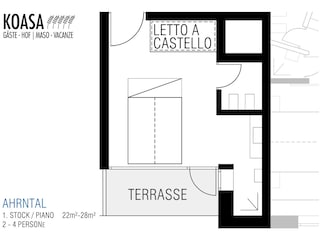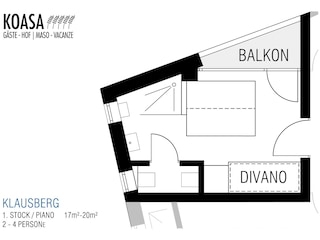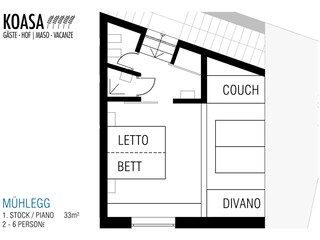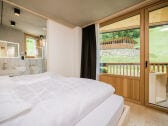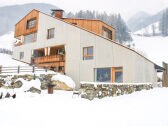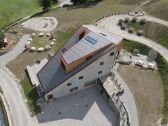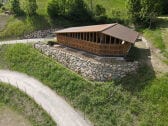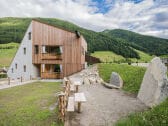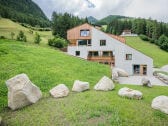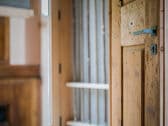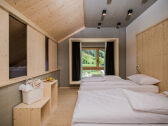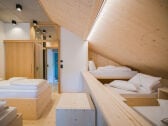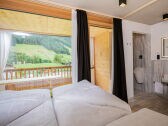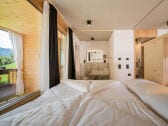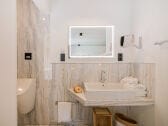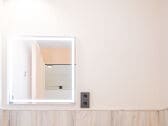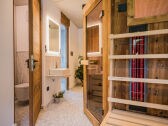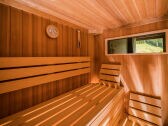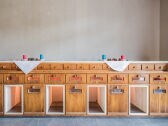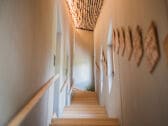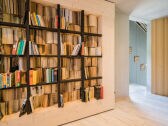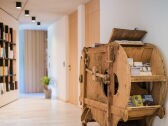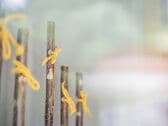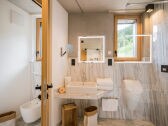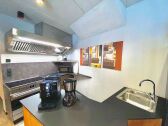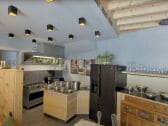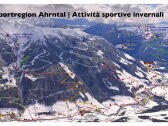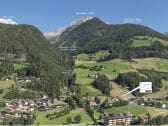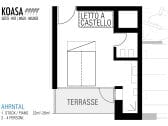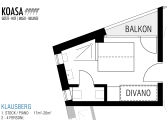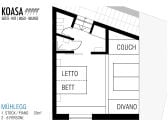1 / 35
Holiday house KOASA-HOF 240m² Superior Chalet, Maso-Vacanze
5 Bedrooms
Max. 18 guests
240 m²
Steinhaus, Ahrntal
View on Map
1 / 35
Please select dates and guests
Description
In 2021, the newly built Koasa-Hof was occupied. Guests will experience farm luxury with hosts Cinzia and Markus in the Ahrntal. The house was constructed with regional materials, some of which are produced on the farm...
Special features
Rent the entire house – Travel for small groups
We have a few ideas why you should come to the Ahrntal Valley with your friends and family. Perhaps you could also organize your company trip with us....
Amenities
5 Bedrooms
Max. 18 guests
240 m²
Free WIFI
Charging station for electric vehicles available
Television
Pets and dogs on request
Sauna
Smoking not allowed
Stairs
Dishwasher
Washing machine
Prices
Please select dates and guests
Usage-dependent additional costs
Please note that additional usage-dependent costs may apply. For questions about this, please contact the host directly.
Host's notes
Cancellation policy
The host has not specified any cancellation conditions
Rental conditions
- •Deposit: 25% of the rental price at time of booking
- •Final payment: by arrangement
- •Security deposit: 25% of the rental price
Payment options
- •Credit card
- •Cash payment
- •Bank transfer
Location
Distances
AIRPORT100 km
BUS STOP200 m
DOCTOR1.5 km
NIGHT LIFE1.4 km
RAILWAY STATION26 km
RESTAURANT900 m
SHOPS400 m
SKI-LIFT1.4 km
TOWN CENTER2.7 km
WATER100 m
Nearby
Our leisure tips
- •Alpine skiing
- •Barbecue
- •Beachvolleyball
- •Birdwatching
- •Campfire
- •Canoeing
- •Cinema
- •Coach rides
- •Cross-country skiing
- •Culture
- •Cycling
- •Football
- •Geocaching
- •Gym
- •Hang-gliding
- •High rope course
- •Hiking
- •Hockey
- •Horseback riding
- •Ice-skating
- •Indoor swimming pool
- •Jogging
- •Miniature golf
- •Mountain biking
- •Mountain hiking
- •Mountaineering
- •Museums
- •Nightlife
- •Nordic walking
- •Open-air pool
- •Paragliding
- •Playground
- •Rafting
- •Rock climbing
- •Sightseeing
- •Skittle alley/bowling
- •Snowboard
- •Spa
- •Summer toboggan run
- •Swimming
- •Table tennis
- •Theme park
- •Tobogganing
- •Volleyball
- •Water park
Other recreational opportunities
Koasa-Hof, a holiday home and guest farm, is located in the Ahrntal, a side valley of the South Tyrolean Puster Valley. Ernst A. Schaubach, a 19th-century alpine researcher, described the Ahrntal as a fork, as from the Taufer Valley, three side valleys branch off: the Reintal, the Mühlwalder Tal, and Weißenbach. So how do you reach Mühlegg in St. Johann-Ahrntal, where Koasa-Hof sits at 1050 meters above sea level on the sunny side?
Take the Brixen Nord motorway exit and turn into the Puster Valley. Follow the state road to the city of Bruneck. Here, the Ahrntal branches off, and you have another 25.5 km to drive.
If you're using public transportation, you can take the train to Bruneck. The train station is near the hospital. From there, the bus line 450 to the Ahrntal departs every 15 minutes. The bus stops several times along the way, in the market town of Sand in Taufers, where you'll find a pharmacy, many shops, and a swimming pool. Get off at the Mühlegg stop and you will see Koasa-Hof about 200 meters away.
Holiday destination
Ahrntal
Nestled between Pojenspitz and Jochkofel, the quaint Ahrntal valley lies within itself. From your Ahrntal room, you gaze directly into this untouched part of the Rieserferner-Ahrn Nature Park. We've positioned the double bed close to the window, so the spectacular distant views can impress you even before you get up. Take a hike up the mountain. Markus will introduce you to the alpine walking stick, the Zintstecken, as we call it in Toule. We wish you a great start to your hiking adventure.
Had enough walking? Then check out the corresponding nature park centers; one is located in Sand in Taufers, the other in Kasern. The exhibitions shed light on the geographic features, fauna, and flora of the region. While you're exploring, you can also discover folk art at the Maranatha Nativity Museum in Luttach. It showcases the highest international carving art, a visual retrospective of Ahrntal's rural history, and a bold look into modern nativity art.
From your Ahrntal room window, you can see who comes and goes. Your view includes the Jakobsbrunnen in the garden and the sun terrace in front of the communal breakfast room. We wish you delightful days in the Ahrntal.
Speikboden
In the morning, your gaze drifts southward – towards the Speikboden recreational area. In the distance, you can make out the ski lifts, discreetly glittering in the sun. Anticipation for a trip up over 2,000 meters, with views of South Tyrol's peaks.
We also recommend a visit to the castle above Sand in Taufers, just a few hundred meters from the Speikboden valley station. The preserved castle complex is well worth a visit, with restored rooms recounting life in the medieval Ahrntal. A stroll through the outer grounds behind the protective walls is enjoyable for both children and adults and can be rewarded with a stop at the castle tavern.
Those who prefer not to wander far in the Speikboden room can delight in the Koasa terrain right in front of the balcony. You overlook the stone circle in the garden, where you are welcome to make a campfire. This evening activity is especially offered to young people, who can also use the room as a quad.
Klausberg
The evening sun is highly coveted in the Ahrntal. Indeed, occupants of the room with a view of the Klausberg are among the lucky ones who can fully enjoy it on the balcony. Those seated here look out onto the boulder rock in the garden and the sun ledge in front of our wooden hut. Here we observe how the mountain meadows change colors throughout the year, who skis down to the valley, and who climbs up early in the morning.
Close to the Klausberg valley station, you'll find a branch of the State Museum of Mining. Who knew that Ahrntal was once a center of Tyrolean mining? Copper mining brought a certain significance to the small valley. A high-quality presentation and entertaining depiction of some of Ahrntal's secrets can be found in the historically significant mining building, the Kornkasten in Steinhaus.
The history goes even further back. A chance discovery allows a glimpse into prehistoric sacrificial offerings to the gods in the centuries before Christ. Artistically presented in a permanently accessible mini-exhibition at the Pfisterhaus in Steinhaus. To see the third pink house in the ensemble from the inside, you may now take a break at the Steinhauswirt and send regards to the hostess Barbara.
Dreiherrn
Alpenglow in the Ahrntal – yes, from the balcony, the glowing evening red of the mountain at the valley's end is visible. This coveted three-thousand-meter peak at the end of the valley is called Dreiherrenspitz because it borders the lands of three lords: Salzburg, East Tyrol, and South Tyrol. We strive to embrace this regionality and have used materials in the Koasa-Hof whose origin (and lords) we know: The wood of the floors comes from our own forests, the marble of the bathrooms was selected in the quarry area in Vinschgau, and the loden fabrics of the curtains were completely made in Bruneck.
So, if you head towards the end of the valley, consider visiting the mining tunnel in Prettau during the summer season. Guided tours in the tunnel illustrate how copper has been mined in the Ahrntal since the Middle Ages. Mining has shaped the valley and still leaves hidden traces today.
We wish all ladies and gentlemen a pleasant stay in the Dreiherren room.
Mühlegg
No balcony, no problem. This room showcases what we can do. A panoramic window with an extra-large windowsill for meditating, reading, and watching is your gateway to the Ahrntal world. You overlook the Mühlegg part of the village, hence the room's name.
The room is almost the center of the house, which is why it is also favored by groups looking for a dormitory experience. This versatile room hides an extension. Behind the wooden paneling, another chic sleeping area appears; for all who want to enlarge the room or share it. All the comforts are included: rain shower, day toilet, bidet, vanity mirror, hairdryer, and straightener for double and quad rooms.
In Mühlegg, there's plenty to do. On foot from the Koasa-Hof, you can quickly visit Klaus's private carving studio and take home souvenirs and a few jokes. A few meters down the stream, you'll find the Mineral Museum of Artur and the Kirchler family. Let yourself be swept away by the treasures of the Ahrntal mountains and the surrounding valleys: The Kirchler family has unearthed huge crystals and precious stones and displays them publicly. It can take your breath away when you learn what the mountains can conceal.
A short hike up, and you'll see the Frankbach waterfalls, thundering down the slope. From here, the Hexensteig is not far, a mystical little hike for the whole family.
Getting there
Koasa-Hof, a holiday home and guest farm, is located in the Ahrntal, a side valley of the South Tyrolean Puster Valley. Ernst A. Schaubach, a 19th-century alpine researcher, described the Ahrntal as a fork, as from the Taufer Valley, three side valleys branch off: the Reintal, the Mühlwalder Valley, and Weißenbach. How do you reach Mühlegg in St. Johann-Ahrntal, where Koasa-Hof sits at 1050 meters above sea level on the sunny side? Take the Brixen Nord motorway exit and turn into the Puster Valley. Follow the state road to the town of Bruneck. Here, the Ahrntal branches off, and you have another 25.5 km to drive. If you are using public transport, you can travel by train to Bruneck. The train station is near the hospital. From there, the bus line 450 to the Ahrntal departs every 15 minutes. The bus stops several times along the way, including in the market town of Sand in Taufers, where there are pharmacies, many shops, and a swimming pool. Get off at the Mühlegg stop and you will see Koasa-Hof about 200 meters away.
Availability
Legend:
Free
Occupied
Contact
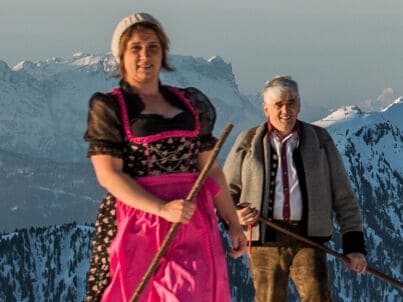
Company KOASA-HOF, Ferienhaus Superior, Maso- Casa Vacanza - Mr Markus WegerGerman and Italian
Accommodation number: 482195
Host informationGuests will experience farm luxury in the Ahrntal Valley with hosts Cinzia and Markus. We have a few ideas why you should come to the Ahrntal Valley with your friends and family. Maybe you could also organize your company trip with us. There's just so much to experience. We will provide you with our complete guest wing for this purpose – and stay out of your vacation.
The Holiday house has no reviews yet
No review has been submitted for this accommodation yet. Write the first review now!
